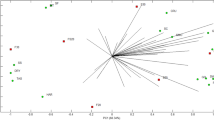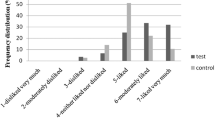Abstract
The aim of this study was to develop a gluten-free formulation of quinoa (Chenopodium quinoa Willd.)-based cookies using experimental design of mixture to optimize a ternary mixture of quinoa flour, quinoa flakes and corn starch for parameters of colour, specific volume and hardness. Nutritional and sensory aspects of the optimized formulation were also assessed. Corn starch had a positive effect on the lightness of the cookies, but increased amounts of quinoa flour and quinoa flakes in the mixture resulted in darker product. Quinoa flour showed a negative effect on the specific volume, producing less bulky cookies, and quinoa flour and quinoa flakes had a positive synergistic effect on the hardness of the cookies. According the results and considering the desirability profile for colour, hardness and specific volume in gluten-free cookies, the optimized formulation contains 30 % quinoa flour, 25 % quinoa flakes and 45 % corn starch. The quinoa-based cookie obtained was characterized as a product rich in dietary fibre, a good source of essential amino acids, linolenic acid and minerals, with good sensory acceptability. These findings reports for the first time the application of quinoa processed as flour and flakes in mixture with corn starch as an alternative ingredient for formulations of gluten-free cookies-type biscuits.


Similar content being viewed by others
References
Adelakun OE, Kudanga T, Parker A et al (2012) Laccase-catalyzed dimerization of ferulic acid amplifies antioxidant activity. J Mol Catal B: Enzym 7:29–35
Agama-Acevedo E, Islas-Hernández JJ, Pacheco-Vargas G, Osorio-Díaz P, Bello-Pérez LA (2012) Starch digestibility and glycemic index of cookies partially substituted with unripe banana flour. LWT Food Sci Technol 46:177–182
Allred LK, Park ES (2012) EZ gluten for the qualitative detection of gluten in foods, beverages, and environmental surfaces. J AOAC Int 95:1106–1117
AOAC (2006) Official methods of analysis of the association of official analytical chemist (18th ed.). Washington. DC USA
APHA (2001) Compendium of methods for the microbiological examination of foods, 4th edn. American Public Health Association, Washington
Bassinello PZ, Freitas DGC, Ascheri JL et al (2011) Characterization of cookies formulated with rice and black bean extruded flours. Proc Food Sci 1:1645–1652
Brenaan CS, Samyue E (2004) Evaluation of starch degradation and textural characteristics of dietary fiber enriched biscuits. Int J Food Prop 7:647–657
Canett-Romero R, Ledesma-Osuna AL, Robles-Sanchéz RM, Morales-Castro R, León-Martínez L, León-Galvez R (2004) Characterization of cookies made with deseeded grape pomace. Arch Latin Nutr 54:93–99
Commission International De L’Eclairage (CIE) (1978) “Recommendations on uniform color spaces, color difference equations, psychometric color terms”. Supplement no. 2 to CIE Publication no. 15, Colorimetry, Bureau Central de la CIE, Paris
Cornell JA (1981) Experiments with mixtures: designs, models, and the analysis of mixture data. Wiley, New York
Dutcosky SD, Grossmann VME, Silva RSSF, Welsch AK (2006) Combined sensory optimization of a prebiotic cereal product using multicomponent mixture experiments. Food Chem 98:630–638
Falguera V, Aliguer N, Falguera M (2012) An integrated approach to current trends in food consumption: moving toward functional and organic products? Food Control 26:274–281
FAO/WHO (1985) Energy and protein requirements: report of a joint FAO/WHO/UNU expert consultation. WHO Tech. Rep. 724. Geneva
Fasolin LH, Almeida GC, Castanho PS, Netto-Oliveira ER (2007) Cookies produced with banana meal: chemical, physical and sensorial evaluation. Food Sci Technol 27:524–529
Feddern V, Durante VVO, Miranda MZ, Mellado MLMS (2011) Physical and sensory evaluation of wheat and rice bran cookies. Braz J Food Technol 14:267–274
Gómez-Caravaca AM, Segura-Carretero A, Fern A, Caboni MF (2011) Simultaneous determination of phenolic compounds and saponins in quinoa (Chenopodium quinoa Willd) by a liquid chromatography-diode array detection-electrospray ionization-time-of-flight mass spectrometry methodology. J Agric Food Chem 59:10815–10825
Gupta M, Singh A, Abu-Ghannam N (2010) Food and bioproducts processing effect of barley flour and freeze – thaw cycles on textural. Food Bio Proc 89:520–527
Harra NM, Lemm T, Smith C (2011) Quinoa flour is an acceptable replacement for all purpose flour in a peanut butter cookie. J Am Diet Assoc 111:SA45
Hartman L, Lago RCA (1973) Rapid preparation of fatty acids methyl esters. Lab Pract 22:475–476
James LEA (2009) Quinoa: composition, chemistry, nutritional, and functional properties. Adv Food Nut Res 58:1–31
Kissel LT, Prentice N, Yamazaki WT (1975) Protein enrichment of cookie flours with wheat gluten and soy flour derivatives. Cereal Chem 52:638–649
Legrand D, Elass E, Carpentier M, Mazurier J (2006) Interactions of lactoferrin with cells involved in immune function. Biochem Cell Biol 84:282–290
Lorenz K, Coulter L, Johnson D (1995) Functional and sensory characteristics of quinoa in foods. Dev Food Sci 37:1031–1041
Mareti MC, Grossmann MVE, Benassi MT (2010) Physical and sensorial characteristics of cookies containing deffated soy flour and oat bran. Food Sci Technol 4:878–883
McWatters KH, Ouedraogo JB, Resurreccion VA et al (2003) Physical and sensory characteristics of sugar cookies containing a mixture of fonio (Digitaria exilis) and cowpea (Vigina unguiculata) flours. Int J Food Sci Technol 38:403–410
Meilgaard M, Civille GV, Carr BT (1987) Sensory evaluation techniques. Florida: CRC Press, 2, 158p
Padovani RM, Amaya-Farfan J, Colugnat FAB, Domene SMA (2006) Dietary reference intakes: application of tables in nutritional studies. Rev Nutr 19:741–760
Pareyt B, Goovaerts M, Broekaert WF, Delcour JA (2011) Arabinoxylan oligosaccharides (AXOS) as a potential sucrose replacer in sugar-snap cookies. LWT Food Sci Technol 44:725–728
Sandstead HH, Prasad AS, Penland JG et al (2008) Zinc deficiency in Mexican American children: influence of zinc and other micronutrients on T cells, cytokines, and antiinflammatory plasma proteins. Am J Clin Nut 88:1067–1073
Secchi N, Stara G, Anedda R et al (2011) Effectiveness of sweet ovine whey powder in increasing the shelf life of Amaretti cookies. LWT Food Sci Technol 44:1073–1078
Singh M, Mohamed A (2007) Influence of gluten-soy protein blends on the quality of reduced carbohydrates cookies. Food Sci Technol 40:353–360
Statsoft. Inc (2004) STATISTICA (data analysis software system) Version 7.0. www.statsoft.com
Stikic R, Glamoclija D, Demin M et al (2012) Agronomical and nutritional evaluation of quinoa seeds (Chenopodium quinoa Willd.) as an ingredient in bread formulations. J Cer Sci 55:132–138
Sudha ML, Vetrimani R, Leelavathi K (2007) Influence of fibre from different cereals on the rheological characteristics of wheat flour dough and on biscuit quality. Food Chem 100:1365–1370
Takata K, Yanaka M, Fujita Y, Ishikawa N (2007) Evaluation of the grain and flour quality in near-isogenic wheat lines with waxy and double-null Wx proteins. Breed Sci 57:79–83
White JA, Hart RJ, Fry JC (1986) An evaluation of the waters Pico-Tag system for the amino-acid analysis of food materials. J Autom Chem 8:170–177
Zucco F, Borsuk Y, Arntfield SD (2011) Physical and nutritional evaluation of wheat cookies supplemented with pulse flours of different particle sizes. LWT Food Sci Technol 44:2070–2076
Acknowledgments
Thanks to National Council of Technological and Scientific Development-Brazil (CNPq), for financial support in the form of scholarship for B.I.L.
Author information
Authors and Affiliations
Corresponding author
Rights and permissions
About this article
Cite this article
Brito, I.L., de Souza, E.L., Felex, S.S.S. et al. Nutritional and sensory characteristics of gluten-free quinoa (Chenopodium quinoa Willd)-based cookies development using an experimental mixture design. J Food Sci Technol 52, 5866–5873 (2015). https://doi.org/10.1007/s13197-014-1659-1
Revised:
Accepted:
Published:
Issue Date:
DOI: https://doi.org/10.1007/s13197-014-1659-1




